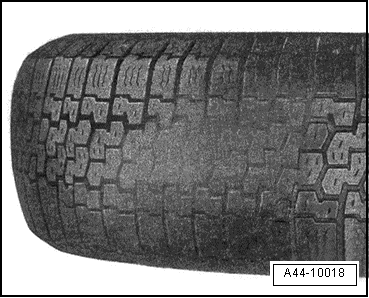| Diagonal washout on a tyre |
| Diagonal washout runs at an angle of approx. 45° to the direction of rotation. |
| It usually occurs at one point only, but can also occur at several points around the circumference of the tyre. |
| Washout occurs almost exclusively on the tyres on the non-driven wheels, in particular at the rear left. Washout occurs very often on some models, while it poses no problem at all on other models. The effect is intensified by high toe-in values. Toe-in values in the region of the lower tolerance limits of the specified alignment values improve the wear pattern. |
| The most pronounced diagonal washout is often found in the area where the tyre components are joined. |
| Wheels with positive toe-in roll with a slip angle even straight ahead. This leads to a diagonal stress in the contact patch or footprint on the tyre/road surface. |
| This wear pattern is intensified when tyre pressure is too low. To avoid such tread wear patterns, the toe-in values of the two rear wheels should be identical and the specified tyre pressures observed. |
| If you detect washout, you should fit the wheels on the driven axle, assuming the washout is identified at an early stage. Deeper washout cannot be repaired. |
| If a customer complains of „diagonal wear spots“, the toe adjustment must be examined. If toe-in is correct, the cause of the diagonal washout is very probably the tyre itself. |
| Tyres with diagonal washout caused by incorrectly set axle geometry at the wheels are not covered by warranty. |
|
|

|

